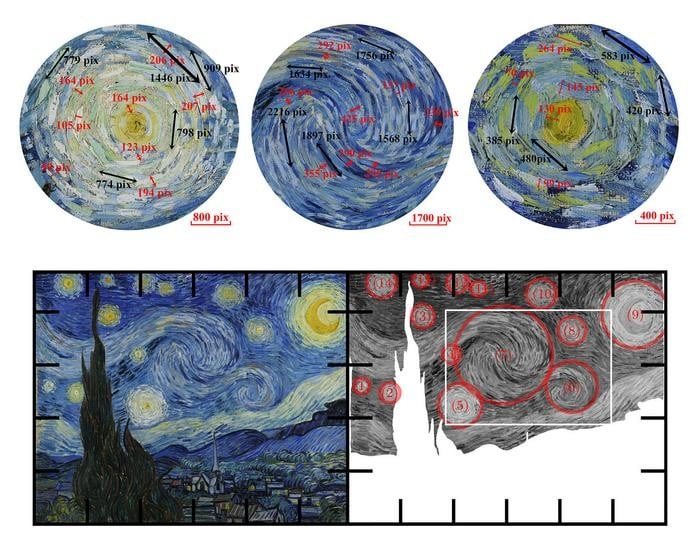Summary: Researchers have discovered that Vincent van Gogh’s “The Starry Night” accurately depicts real-world atmospheric physics, suggesting the artist had an innate understanding of turbulence.
Estimated reading time: 5 minutes
A new study published in Physics of Fluids has uncovered a surprising connection between art and science in Vincent van Gogh’s iconic painting “The Starry Night.” Researchers from China and France have found that the swirling patterns in the night sky of the painting align with established theories of fluid dynamics and turbulence.
Brushstrokes as Data Points
The team of atmospheric scientists and fluid dynamics experts analyzed high-resolution digital images of “The Starry Night” to measure the scale and spacing of van Gogh’s brushstrokes. They used the relative brightness, or luminance, of the paint colors as a proxy for the kinetic energy of physical movement in the atmosphere.
“The scale of the paint strokes played a crucial role,” said author Yongxiang Huang. “With a high-resolution digital picture, we were able to measure precisely the typical size of the brushstrokes and compare these to the scales expected from turbulence theories.”
Aligning with Atmospheric Physics
The researchers examined the spatial scale of the painting’s 14 main whirling shapes to determine if they correspond to the cascading energy theory that describes how kinetic energy transfers from large to small scales in atmospheric turbulence.
Their analysis revealed two key findings:
- The overall picture aligns with Kolmogorov’s law, which predicts atmospheric movement and scale according to measured inertial energy.
- At the microscopic level of individual brushstrokes, the researchers found alignment with Batchelor’s scaling, which describes energy laws in small-scale, passive scalar turbulence.
Finding both of these scaling laws represented in a single atmospheric system is rare, making this discovery particularly significant.
Implications and Future Research
This study suggests that van Gogh had a deep intuitive understanding of natural phenomena, whether through careful observation or an innate sense of atmospheric dynamics.
“It reveals a deep and intuitive understanding of natural phenomena,” Huang said. “Van Gogh’s precise representation of turbulence might be from studying the movement of clouds and the atmosphere or an innate sense of how to capture the dynamism of the sky.”
The findings also have implications beyond art appreciation. The researchers believe this work could contribute to expanding our understanding of turbulence itself.
“It seems it is time to propose a new definition of turbulence to embrace more situations,” Huang noted, referring to recent observations of turbulence-like phenomena in various flow systems with low Reynolds numbers.
Limitations and Questions
While the study provides fascinating insights, it’s important to note some limitations:
- The analysis is based on a static image, not a dynamic system.
- The interpretation of paint luminance as kinetic energy is a proxy measure.
- Van Gogh’s intent and process in creating these patterns cannot be known for certain.
Future research could explore whether similar patterns emerge in other artworks depicting natural phenomena, or how this understanding of turbulence representation could inform computer-generated imagery in films and visual effects.
Quiz
- What law does the overall picture of “The Starry Night” align with, according to the study? a) Newton’s law b) Kolmogorov’s law c) Ohm’s law d) Boyle’s law
- At the microscopic level of brushstrokes, what scaling did researchers find alignment with? a) Einstein’s scaling b) Planck’s scaling c) Batchelor’s scaling d) Richter’s scaling
- How many main whirling shapes did the researchers examine in the painting? a) 7 b) 10 c) 14 d) 20
Answers:
- b) Kolmogorov’s law
- c) Batchelor’s scaling
- c) 14
Glossary of Terms:
- Turbulence: Chaotic changes in pressure and flow velocity in a fluid.
- Kolmogorov’s law: A theory describing the energy spectrum of turbulence in fluid flows.
- Batchelor’s scaling: A theory describing the behavior of passive scalars in turbulent flows.
- Luminance: The intensity of light emitted from a surface per unit area.
- Reynolds number: A dimensionless quantity used to predict flow patterns in different fluid flow situations.
- Kinetic energy: The energy that an object possesses due to its motion.
Enjoy this story? Get our newsletter! https://scienceblog.substack.com/
If our reporting has informed or inspired you, please consider making a donation. Every contribution, no matter the size, empowers us to continue delivering accurate, engaging, and trustworthy science and medical news. Independent journalism requires time, effort, and resources—your support ensures we can keep uncovering the stories that matter most to you.
Join us in making knowledge accessible and impactful. Thank you for standing with us!

